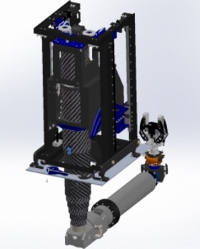US waste management specialist Kurion has been awarded a contract to develop a new robotic system for the second phase of repairs in the primary reactor containment at Fukushima Daiichi. The Fukushima Repair Manipulator, or FRM, is targeted for deployment in mid-2016.
 |
| A robotic arm will repair leaks in the containment (Image: Kurion) |
The FRM follows on from the first phase of efforts to identify and repair leaks in the primary containment using the Fukushima Inspection Manipulator (FIM) robotic system, which used three remotely operated vehicles (ROVs) to identify cracks in the primary containment vessel, vent tubes and torus located in the reactor building.
The first inspection provided information to move forward with the second phase of the repair efforts. The FIM is scheduled to complete inspections of seven more locations in the reactor building in March 2015, providing further information to refine the FRM design requirements and identify the full scope of repair activities.
The FRM's prime objective will be to plug leaks in the containment. This will significantly reduce the amount of water which is currently being used to cool the core, which becomes contaminated in the process.
The system will provide operators with remote access to the reactor to open holes, clear debris and obstacles, and plug cracks in the reactor’s vent tubes and torus. The system will include a robotic arm outfitted with advanced cutting, water-jet and grouting tools, and will feature new automatic control sequences to guide these complex tasks.
Kurion CEO Bill Gallo described access to radioactive and hazardous environments as a crucial piece of the waste management puzzle. "Each project is unique, posing an engineering challenge that demands a custom robotics systems that can complete tasks where humans can’t operate," he said.
Researched and written
by World Nuclear News




_91467.jpg)
_47120.jpg)
_16439.jpg)






